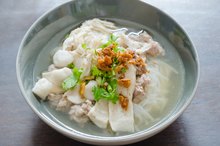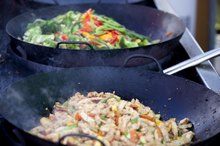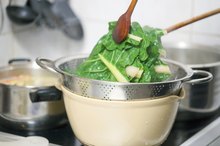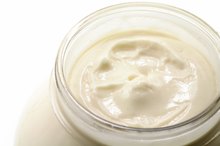What does fact checked mean?
At Healthfully, we strive to deliver objective content that is accurate and up-to-date. Our team periodically reviews articles in order to ensure content quality. The sources cited below consist of evidence from peer-reviewed journals, prominent medical organizations, academic associations, and government data.
- Centers for Disease Control and Prevention: Sodium: The Facts
- Academy of Nutrition and Dietetics: Does Microwaving Food Destroy the Vitamins?
The information contained on this site is for informational purposes only, and should not be used as a substitute for the advice of a professional health care provider. Please check with the appropriate physician regarding health questions and concerns. Although we strive to deliver accurate and up-to-date information, no guarantee to that effect is made.
Is Wok Cooking Healthy?
Wok cooking, also called stir-frying, can be a healthy way to prepare your meals, especially if you use plenty of vegetables in your dish 5. This is only the case, however, if you limit the number of high-sodium and high-fat ingredients and don't add a lot of oil or fat during the cooking process.
Limits Fat Content
When stir-frying foods, you only need a minimal amount of oil due to the high heat used in this cooking method. You can even replace the fat with broth to lower the final fat content of your meal even more. You'll want to include at least a small amount of fat, either from the oil used to stir-fry your food or in the form of meat or nuts because otherwise you won't be able to absorb all of the fat-soluble vitamins from the vegetables in the dish.
Helps Minimize Nutrient Losses
How to Cook Watercress
Learn More
Long cooking times increase the loss of heat-sensitive vitamins, including vitamin C and the B vitamin thiamine. Quickly stir-frying vegetables in a small amount of oil helps minimize these losses. Although the high temperatures used will still cause some nutrient losses, these will be less than if you grilled, baked or roasted your vegetables because of the much shorter cooking time, according to ConsumerReports.org 5.
- Long cooking times increase the loss of heat-sensitive vitamins, including vitamin C and the B vitamin thiamine.
- Although the high temperatures used will still cause some nutrient losses, these will be less than if you grilled, baked or roasted your vegetables because of the much shorter cooking time, according to ConsumerReports.org 5.
Sodium Considerations
The average American consumes 3,400 milligrams of sodium per day, according to the Centers for Disease Control and Prevention 6. This is way more than the recommended limit of 2,300 milligrams per day for healthy people. Consuming too much sodium can increase your risk for high blood pressure and heart disease. Sauces commonly used when cooking in a wok, such as soy sauce or chicken broth, tend to be high in sodium. Use low-sodium versions or use other liquids or spices, such as lemon juice, rice wine vinegar, chilies, garlic or ginger, to flavor your stir-fry to minimize its sodium content.
- The average American consumes 3,400 milligrams of sodium per day, according to the Centers for Disease Control and Prevention 6.
- Sauces commonly used when cooking in a wok, such as soy sauce or chicken broth, tend to be high in sodium.
Getting the Best Results
How to Make Soups Using Center-Cut Beef Shanks
Learn More
Given the typical American stove, a stir-fry pan may be a better option than a traditional wok since it will heat more evenly but still allow you to quickly stir your food without it slipping over the sides, recommends a March 2011 article in "Fine Cooking." Prepare all of your ingredients ahead of time, cutting everything into similar-sized pieces so the ingredients cook at the same speed 3. Put the meat in the pan first, stirring it constantly until it is done cooking. Remove the meat and add the vegetables that take longer to cook, then the quick-cooking vegetables 5. Add the sauce and return the meat to the pan near the end of the cooking time 3.
Related Articles
References
- North Dakota State University Extension: Prairie Fare: Stir-fry Your Way to a Healthier Diet
- Alabama Cooperative Extension System: Stir Fry Your Way to Healthy Eating
- Fine Cooking: Consider a Stir-Fry Pan Instead of a Wok
- Epicurious: Stir-Fry Recipes and Tips
- Fine Cooking: The Right Way to Cook Vegetables
- Centers for Disease Control and Prevention: Sodium: The Facts
- Consumer Reports: Get More Out of Your Vegetables
- Center for Disease Control. Prediabetes—your chance to prevent type 2 diabetes.
- McMacken M, Shah S. A plant-based diet for the prevention and treatment of type 2 diabetes. J Geriatr Cardiol. 2017;14(5):342-354. doi:10.11909/j.issn.1671-5411.2017.05.009
- Olfert MD, Wattick RA. Vegetarian diets and the risk of diabetes. Curr Diab Rep. 2018;18(11):101. doi:10.1007/s11892-018-1070-9
- Zheng J, Sharp S, Imamura F, et al. Association of plasma biomarkers of fruit and vegetable intake with incident type 2 diabetes: EPIC-InterAct case-cohort study in eight European countries. BMJ. 2020 Jul 8;370:m2194. doi:10.1136/bmj.m2194
- Lattimer JM, Haub MD. Effects of dietary fiber and its components on metabolic health. Nutrients. 2010;2(12):1266-1289. doi:10.3390/nu2121266
- The American Institute of Cancer Research. Five steps for cancer safe grilling. Updated June 28, 2018.
Writer Bio
Based in Massachusetts, Jessica Bruso has been writing since 2008. She holds a master of science degree in food policy and applied nutrition and a bachelor of arts degree in international relations, both from Tufts University.









